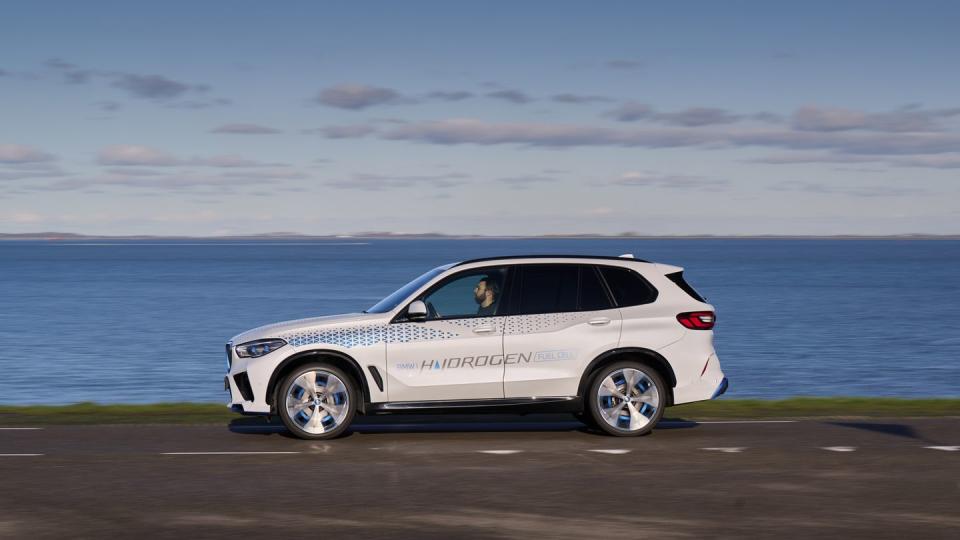2023 BMW iX5 Hydrogen Is a Key Niche Player

It will take a range of solutions to realize the carbon-neutral operations many automakers, including BMW, have pledged to reach by the middle of this century. Battery-electric vehicles (BEVs) will shoulder the bulk of the clean-energy load going forward, but the German manufacturer is not alone in believing that hydrogen-powered fuel-cell vehicles (FCVs) will be an essential part of the mix. Honda, Hyundai, and Toyota also share that sentiment with their current and upcoming FCV models. After driving a new iX5 FCV prototype in Belgium, we came away thinking that BMW may be onto something, even if that something likely won't come to fruition for another decade or two.
Fewer than 100 iX5s will be built this year as part of a demonstration fleet for various regulatory bodies and marketing endeavors. Only a small handful will come to the United States, where—unlike Central Europe and parts of Asia—hydrogen infrastructure is practically nonexistent outside of California. Production entails shipping an X5 from its Spartanburg, South Carolina, birthplace to the BMW Research and Innovation Center in Munich. There, they fit a new floor to accommodate the iX5's two cylindrical, carbon-fiber hydrogen tanks nestled in its center tunnel and under the rear seat. Fuel capacity amounts to about 16 pounds of gaseous hydrogen pressurized to 10,150 psi, which is good for around 310 miles of estimated range per Europe's optimistic WTLP methodology (that equates to about 260 miles of range in the U.S., according to the EPA's cycles). Unlike with a BEV, refilling the iX5 at one of the hydrogen stations around Antwerp only takes a few minutes and will be familiar to anyone who has ever pumped their own gas.
Under the iX5's cargo area is a rear drive axle and current-excited synchronous motor from a BMW iX. Sitting atop it is 400-volt lithium-ion battery with about 2.0 kWh of usable capacity, which exists as a power buffer to the fuel cell to aid in acceleration and also to recoup energy under braking. The fuel-cell stack itself resides under the iX5's hood and includes core cell elements from BMW's longtime FCV partner, Toyota. BMW developed the rest of the assembly, including the stack's cooler and humidifier that optimize the system's air quality, plus a powerful compressor to quickly shove oxygen into the cells' membranes, where the main chemical reaction takes place. According to BMW, these enhancements result in both quick response to accelerator inputs and the fuel cell's ability to continuously run at maximum power. As with all FCVs, electricity and water vapor are the only byproducts, with total system output a respectable 395 horsepower.
You'll be able to spot the iX5 by its many blue accents and the stickers running across its hood and down its flanks. From behind the wheel, the experience is wholly uneventful, which is the point. This vehicle drives exactly as you'd expect an electric X5 to—smooth, quiet, and refined. Its steering is pleasantly direct, and its air springs and adaptive dampers return nicely balanced body motions. Ride comfort on our sample car's 20-inch run-flat winter tires was good, though the standard 22-inch Pirelli P Zeros surely will degrade that a bit. Several drive modes vary the iX5's sportiness accordingly, while paddles on its steering wheel adjust the regenerative braking from a little to quite a lot. Mat the right pedal, and the Bimmer accelerates briskly with the low-end punch of a BEV, thanks in part to the fuel cells' ability to simultaneously contribute energy to the traction motor and help maintain a high state of charge for the battery. Traffic congestion during our drive provided us with zero opportunity for fun, but BMW's claims of acceleration to 62 mph in around six seconds and a 115-mph top speed are entirely believable.

 Yahoo Autos
Yahoo Autos 